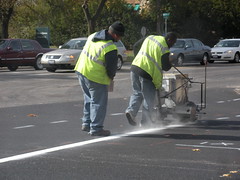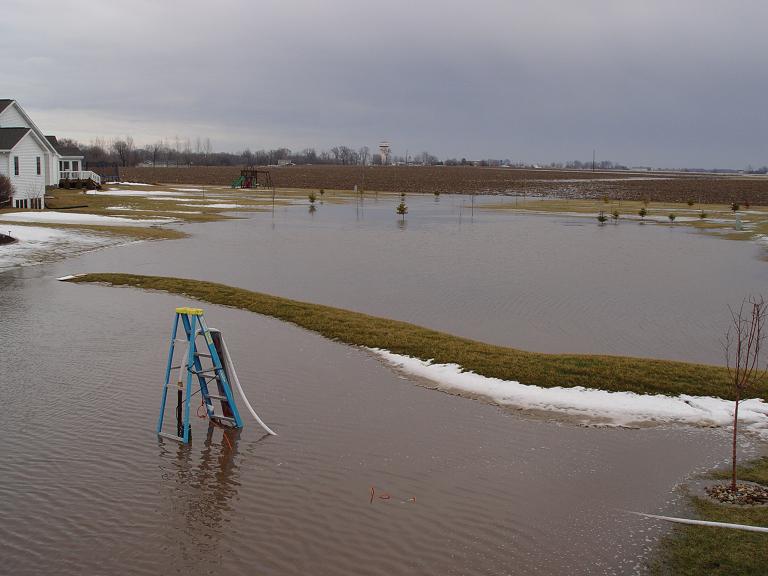Day 5
The main items grabbing my attention today involved the following:
Striping
Today the stripers were in town placing the thermoplastic paint on a few of our newly paved roads. Normally I don't get too involved in the operation because we have a project engineer and technician inspecting and managing the project. But today, we had a resident call because she was concerned that we had planned to stripe a crosswalk at a T-intersection. There had been one leg of a sidewalk connection with a depressed ramp on her side, but no connecting sidewalk on the other side of the road. We've been trying to clean these up and either remove the lone leg or add the other side. In this case we added the receiving ramp. Because the roadway is busy, the engineer had planned on placing a crosswalk at this point. However the resident was worried children would be harmed because the crosswalk might encourage them to cross there rather than further down at the 4-way stop.

I met the resident and her husband at the site along with one of our policemen. Over the years I've found it to be a very valuable experience to work together with the police on traffic-related issues. They bring great insight and ideas. And in the end, they are the ones that have to regulate the traffic. The policeman who met me there is an awesome public safety professional who was able to offer his thoughts from a public safety perspective. He shared that we have crosswalks striped all over town at T-intersections, and the police have had no incidents reported. And I indicated there would be no engineering reason that requires us to stripe or not stripe. After reviewing the situation, we decided that based on the four-way stop being close by, we could skip striping the crosswalk.
Storm Sewer Project
We regularly receive calls related to stormwater issues throughout the community. Most of the time, they do not meet the criteria required for the city to install additional infrastructure. But occasionally the water nuisance is extensive enough that we decide to construct an improvement. This year, we have plans to install a short segment of storm sewer to alleviate flooding that occurs over multiple properties after even a small amount of rainfall. Our crews will do the work so normally we would not prepare a normal set of plans required for bidding. But because we have some interns who are interested in learning CAD, I decided to set up a drawing for them so they could work on developing the plan for this project. Unfortunately we have a CAD product that based on my experience requires us to spend an enormous amount of time that could be cut significantly if we just changed software. But even though over time the new software would pay for itself in savings from subscription fees, it's that initial purchase price that in this economy is preventing me from changing over. So instead every time we draw something, we spend a lot of time generating the plans. To say it's been frustrating is a total understatement. Anyway, I finally today managed to get the plan set up for them to start. Although I never could get the linestyles to display right. And because I just cannot afford to spend more time with it, I am hoping the interns can figure out what is messed up with that.
Reviewing a Driveway Permit
Normally this would be handled by our building department since they issue driveway replacement permits. But last year we had a company come in–well it was more like a guy with a skidsteer who didn't have a clue what he was doing–and in the process of trying to cut curb completely messed up a newly paved road. Why he waited until we completed the road to cut curb and replace drives is still not evident, but the result was damaged pavement because he didn't properly perform this work. So now we are more cautious about letting anyone cut curb. In this case, the contractor seems to be using a reputable company so I expect they will pick up their permit on Monday after dropping off the necessary certificates of insurance and bond we require to work in the right of way.
School Zones
One of our engineers had noticed that some school zone signs remained in areas where schools had moved out of their buildings. He wondered if we should remove the signs so I had our interns looking into this. Today we checked the city code to determine where the city council had established school zones and discovered there seemed to be some school zones still in existance even though schools are no longer located in those areas. And because we have had so much development in the past several years, there are areas with signed school zones that have not been established through ordinance. So the interns are preparing a report of these areas that can be submitted to administration and perhaps onto the council for consideration.
Some of the miscellaneous tasks that filled the rest of the day included:
- Meeting with an intern who will start working part time with us later this month. This is an unpaid internship arranged through the high school.
- Reviewed in the field the site of a proposed development
- Gave our sign shop the sign design our interns prepared for the school zone area


